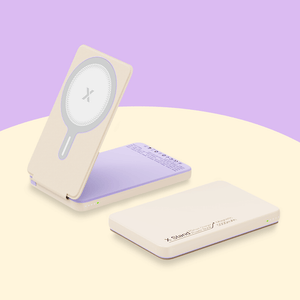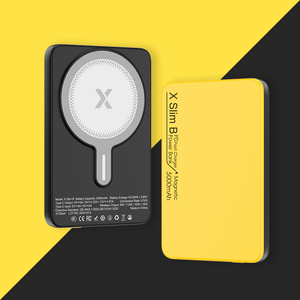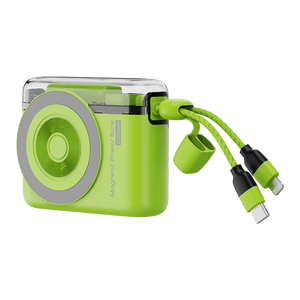Best Portable Power Bank for Phones: Top 5 Pocket Power Picks

You don’t realize how much you rely on your phone — until it dies halfway through the day. Whether it’s navigating, paying, or just staying connected, one low-battery warning can throw everything off. That’s why finding the best portable power bank for phones isn’t just about convenience anymore — it’s about staying powered when you need it most.
But the problem is that most power banks are either too bulky to carry comfortably or too weak to deliver a full charge. What you really need is a small power bank for phone charging that’s light, fast, and reliable — one that can bring your device back to 100% without overheating, slowing down, or making exaggerated capacity claims.
This guide rounds up the five best portable power banks for phones that actually meet that balance. Each one is compact, travel-friendly, and reliable enough to save you from battery anxiety. And among them, one stands out for its blend of thoughtful design, safety, and real-world performance — the XYZtech X Mobile A Mini Power Bank.
Let’s break down how it compares with four other top picks and help you decide which pocket-sized charger deserves a spot in your everyday carry.
Let’s get started!
The Pocket Power Quest: Defining the Perfect Small Power Bank for Phone
The ideal power bank for daily use is one you forget you're carrying until you need it. For most modern smartphones, a true 5,000mAh capacity is the magic number. It provides roughly one to one-and-a-half full charges for the average iPhone or Android device, which is more than enough to get you through an unexpectedly long day, a delayed flight, or a forgotten charger.
This sweet spot balances the power delivery you need with the extreme portability you demand, which is precisely what defines the best portable power bank for cell phone users on the go. We’re looking for units that are light, compact, and address the common pain points:
- The Bulk Barrier: It must fit comfortably in a pocket, not just a backpack.
- The Heat Hazard: Quality features like NTC (Negative Temperature Coefficient) or dynamic thermal sensors are essential to prevent overheating and protect your phone's battery health.
- The Slow Output Snag: It needs to support modern fast-charging standards like Power Delivery (PD) to get your phone back in action ASAP.
- The Trust Factor: The internal components and construction must be reliable to ensure the stated capacity is the usable capacity.
Let's get to the five best options on the market that deliver on this promise.
The Best Portable Power Bank for Phones: Top 5 Picks
Here are the mini marvels that lead the category, offering a perfect blend of power and pocketability.
|
Feature |
XYZtech X Mobile A Mini |
Anker Nano (Foldable USB-C) |
Nitecore NW5000 |
Anker 511 Fusion 5K |
Baseus PicoGo 5K |
|
Capacity |
5,000 mAh |
5,000 mAh |
5,000 mAh |
5,000 mAh |
5,000 mAh |
|
Form Factor |
Short/Thick |
Short/Thick (Plug) |
Slim/Flat (Magnetic) |
Long/Stick (AC Plug) |
Slim/Flat (Magnetic) |
|
Weight |
103g |
100g |
120g |
170g |
130g |
|
Max Wired Output |
15W |
22.5W |
20W |
20W |
20W |
|
Wireless Charging |
No |
No |
Yes (15W) |
No |
Yes (15W) |
|
Integrated Cable/Plug |
Built-in Cable and Plug |
Built-in Foldable Plug |
None |
Built-in AC Wall Plug |
None |
|
Safety Feature |
NTC Temp Control, Fireproof ABS |
ActiveShield™ 2.0 (Dynamic Temp Sensor) |
IPX5 Rating, Over-temp Protection |
Safe Recharging Circuitry |
NTC Temp Control |
|
Approx. Price |
$24.99 |
~$25 - $30 |
~$70 |
~$30 |
~$50 |
1. XYZtech X Mobile A Mini Power Bank
Price: $24.99
Capacity: 5,000 mAh
Weight: 103g
Form: Short/Thick (Integrated Cable/Plug)
Output: 15W Wired

Image via XYZtech
The Gist: The no-fuss, no-cable-required solution that perfectly balances features, reliability, and cost.
- XYZtech has entered the arena with a charger that focuses squarely on practicality and value, addressing the most common user frustration: missing cables. The X Mobile A isn't just a power bank; it's a completely self-contained charging solution designed for grab-and-go convenience.
- What truly sets it apart is its unique dual-integrated design. It features both a built-in USB-C fast-charging cable and a folding USB-C plug. This means you can charge your phone without carrying a separate cable, and recharge the bank itself by simply plugging it into any USB-C wall adapter or laptop port. Despite its powerful feature set, it remains extremely light and compact, weighing in at a mere 103 grams and boasting a chunky-yet-pocketable size thanks to its high-performance cylindrical battery cell.
|
Pros |
Cons |
|
👍 Ultra-Light & Pocketable: A comfortable 103g weight. 👍 Built-in Cable and Plug: True grab-and-go convenience for charging and recharging. 👍 Exceptional Value: At $24.99, it undercuts many comparable options with fewer features. 👍 Reliable Safety: Includes NTC temperature control and utilizes fireproof ABS plastic. |
👎 Max wired output is 15W (sufficient for most, but slower than some 20W options). 👎 Lacks wireless or magnetic charging capabilities. 👎 The short, wide form factor might feel different than a stick or slim magnetic pack. |
2. Anker Nano Power Bank (Foldable USB-C)
Price: ~$25 - $30
Capacity: 5,000 mAh
Weight: 100g
Form: Lipstick/Plug-in
Output: 22.5W Wired

Image via Anker
The Gist: The lightest, fastest, and most minimalist option for cable-free, direct plug-in charging.
- Anker's Nano series takes the "no cable needed" concept and executes it with a sleek, lipstick-sized form factor. Its signature feature is the built-in, foldable USB-C connector that plugs directly into the bottom of your phone, eliminating the need for a separate cable entirely. This is a fantastic feature for minimalism, especially since the connector is designed to accommodate most phone cases.
- Crucially, the Nano delivers a faster 22.5W max output, ensuring your compatible device charges at maximum speed. At an incredible 100g, it is one of the lightest units available. For users who prioritize speed and an ultra-clean look, the Anker Nano makes a powerful case for being the best portable power bank for phones that value a direct-connect design.
|
Pros |
Cons |
|
👍 Smallest & Lightest: Weighs virtually nothing at just 100 grams. 👍 Powerful Output: Delivers up to 22.5W of power for rapid charging. 👍 Advanced Safety: Features ActiveShield™ 2.0 with a dynamic temperature sensor for enhanced protection. |
👎 Can be awkward to use your phone while it’s plugged directly into the port, requiring you to hold both. 👎 The built-in connector is USB-C only (no cable or second port). |
3. Nitecore NW5000
Price: ~$70
Capacity: 5,000 mAh
Weight: 120g
Form: Ultra-Slim (Magnetic)
Output: 20W Wired | 15W Wireless

Image via Nitecore
The Gist: An extremely thin, magnetic, and durable charger built with high-end, rugged materials.
- For the enthusiast who demands extreme durability and the absolute minimum weight possible, the Nitecore NW5000 is a masterclass in engineering. Nitecore built this power bank with a forged carbon fiber shell, resulting in a power bank that is incredibly durable, resistant to wear, and yet remains ultra-light at 120g.
- Furthermore, it is incredibly thin—just 10.6mm—making it one of the flattest choices available. It also features high-speed 15W magnetic wireless charging (compatible with MagSafe), making it perfect for those who want a snap-on, cable-free experience with an element of ruggedness and an IPX5 water-resistant rating. For users who prioritize a blend of rugged protection and effortless wireless charging, this model is a compelling choice as the best power bank for phone charging.
|
Pros |
Cons |
|
👍 Extreme Durability: Forged carbon fiber shell is rugged, thin, and corrosion-resistant. 👍 15W Magnetic Wireless: Fast, cable-free charging for compatible devices (iPhone 12 and later, plus Qi2). 👍 Ultra-Slim Profile: At 10.6mm, it slides into even the tightest pockets easily. |
👎 It is a specialty/niche brand, which usually results in a higher price point. 👎 No built-in cable or plug—you must carry a separate USB-C cable for wired charging or recharging. 👎 No digital display (uses LED indicators). |
4. Anker 511 Power Bank (PowerCore Fusion 5K)
Price: ~$30
Capacity: 5,000 mAh
Weight: 170g
Form: Long/Stick (AC Plug)
Output: 20W Wired

Image via Anker
The Gist: A 2-in-1 hybrid that simplifies packing by combining a wall charger and a portable battery.
- If your pain point is having to carry both a wall adapter and a power bank, the Anker 511 is your solution. This device is a portable charger with wall plug that combines a 5,000mAh portable power with a built-in, foldable AC wall plug. You can use it to charge your phone from an outlet, and then disconnect it and take the fully charged 5,000mAh battery with you. When the battery runs low, you simply plug it into a wall to recharge itself—no cable, no power brick needed.
- While its 170g weight makes it the heaviest of the top 5, the trade-off is the elimination of carrying two separate items, which is a major win for travel and "one-bag" users.
|
Pros |
Cons |
|
👍 2-in-1 Functionality: Eliminates the need for a wall charger for recharging the bank or powering your phone from an outlet. 👍 Fast Self-Recharge: Goes from empty to full in about 2.5 hours when plugged in. 👍 Reliable 20W Output: Fast Power Delivery output to quickly charge modern phones. |
👎 Heaviest on the list (170g) due to the built-in AC prongs. 👎 The "stick" form factor is longer and thicker than the competition. |
5. Baseus PicoGo 5K
Price: ~$50
Capacity: 5,000 mAh
Weight: 130g
Form: Slim/Flat (Magnetic + Stand)
Output: 20W Wired | 15W Wireless

Image via Baseus
The Gist: The best option for a thin, magnetic charger with high-speed wired charging.
- The Baseus PicoGo 5K is the choice for those who prioritize the slimmest possible profile and modern charging versatility. While the Nitecore emphasizes ruggedness, the PicoGo focuses on extreme thinness and high output in a more standard package.
- At just 7.6mm thick, the PicoGo is arguably the most pocket-friendly small power bank for phone users who want to minimize bulk.. It also offers the coveted combination of 15W magnetic wireless charging and a powerful 20W wired USB-C output, providing versatility for both new and older devices. As a strong contender in the accessories space, Baseus utilizes NTC temperature control to maintain safe, steady charging, directly addressing the overheating pain point. The sleek, flat design makes it a beautiful addition to any minimalist daily carry.
|
Pros |
Cons |
|
👍 Thinnest Profile: At 7.6mm, it causes minimal pocket bulge. 👍 Versatile Output: Offers both 20W wired and 15W magnetic wireless charging. 👍 Added Functionality: Designed for a seamless, minimalist attachment to your phone. |
👎 Higher price point, comparable to a premium brand. 👎 Higher price point, comparable to a premium brand. 👎 Requires carrying a separate USB-C cable. |
The Hidden Power: Understanding Specs Beyond the mAh
The raw capacity (5,000mAh) is the starting point, but the true quality of a power bank lies in the technical specifications and safety features—details that often separate the reliable options from the risky ones. When investing in a pocket charger, pay close attention to these three critical factors to ensure you're getting a high-quality smartphone power bank:
1. Power Delivery (PD) Output and Wattage
A capacity of 5,000mAh is useless if the charger can't deliver power quickly. Modern smartphones use the Power Delivery (PD) protocol to negotiate the fastest charging speed.
- 15W (e.g., XYZtech X Mobile A): This is a solid, reliable fast-charging speed, often sufficient to charge a phone from 0% to 50% in about 30–40 minutes.
- 20W or 22.5W (e.g., Anker Nano, Baseus PicoGo): This higher wattage offers slightly quicker charging for compatible devices, pushing the limits of the phone’s charging capabilities.
If your phone supports 20W charging, choosing a bank with 20W output will yield a faster result, but for general use and overnight charging, 15W is perfectly adequate and often keeps costs lower.
2. The NTC Temperature Control Standard
One of the biggest concerns with compact, high-output power banks is overheating, which can damage the internal battery cells of both the charger and your phone.
- NTC (Negative Temperature Coefficient) Thermistors: Featured in the XYZtech X Mobile A and Baseus PicoGo, these sensors actively monitor the battery's temperature. If the temperature exceeds a safe threshold, the circuit automatically reduces the charging current or shuts off, preventing thermal runaway and ensuring safety.
- Dynamic Thermal Sensors (e.g., Anker's ActiveShield™): These are advanced systems that perform similar protective functions, constantly monitoring the temperature during charging.
Always verify that your chosen pocket charger includes robust thermal management—it's non-negotiable for long-term reliability.
3. Cycle Life and Material Quality
A power bank's lifespan is measured by its charge and discharge cycles (e.g., 1000 cycles for the XYZtech X Mobile A). This number indicates how many times the battery can be fully charged and depleted before its capacity significantly degrades (typically to 80% of its original rating). A higher cycle life signifies a higher-quality battery cell, which is crucial for repeat buyers looking for durability.
Furthermore, look for construction materials like ABS fireproof plastic (used by XYZtech) or durable materials like forged carbon fiber (used by Nitecore). These materials ensure the casing is not only resilient but also safe in the event of an internal fault.
Final Thoughts: Your Pocket Power Decision
Finding the best portable power bank for phones is all about striking the right balance between power, portability, and performance. The goal is simple: you want dependable, fast charging without adding bulk to your pocket or bag.
- Best Overall Value & Convenience: The XYZtech X Mobile A Mini Power Bank is the standout choice for most users. Its integrated cable and plug, combined with NTC temperature control and a lightweight build (103g), make it the most practical, grab-and-go solution at an exceptional price point.
- Need Maximum Speed: Opt for the Anker Nano or Baseus PicoGo if a 20W+ output is essential for the fastest possible top-up.
- Simplify Your Travel Bag: The Anker 511 Fusion 5K is the definitive pick for travelers, eliminating the need for a separate wall charger.
Ultimately, by prioritizing genuine portability (under 130g), verifying thermal safety features, and choosing the integrated design that best fits your daily carry, you can confidently select a small power bank for phone that will silence your battery anxiety for good.
Frequently Asked Questions
Q: Is a 5,000mAh power bank sufficient for my large-screen or "Ultra" smartphone model?
A 5,000mAh power bank will typically provide slightly less than one full charge for the largest modern smartphones, whose internal batteries can be 4,500mAh to 5,00mAh or more. Due to energy conversion loss (typically around 15–20%), the actual usable capacity is closer to 3,300mAh to 4,00mAh. It is perfect for a crucial top-up to get you through the rest of the day, but a full 0% to 100% charge may require a slightly larger bank.
Q: What’s the difference between PD (Power Delivery) and regular USB charging?
PD charging allows your device to receive higher power levels safely, resulting in much faster charging compared to standard USB outputs. For example, a 15W PD charger can charge a phone up to 50% faster than a 10W standard port.
Q: Why does my power bank’s capacity seem lower than advertised when charging my phone?
It’s normal to lose about 20–30% of capacity due to voltage conversion and energy transfer loss. A 5,000mAh power bank typically delivers around 3,500–4,000mAh of usable power to your phone — enough for one solid charge.








